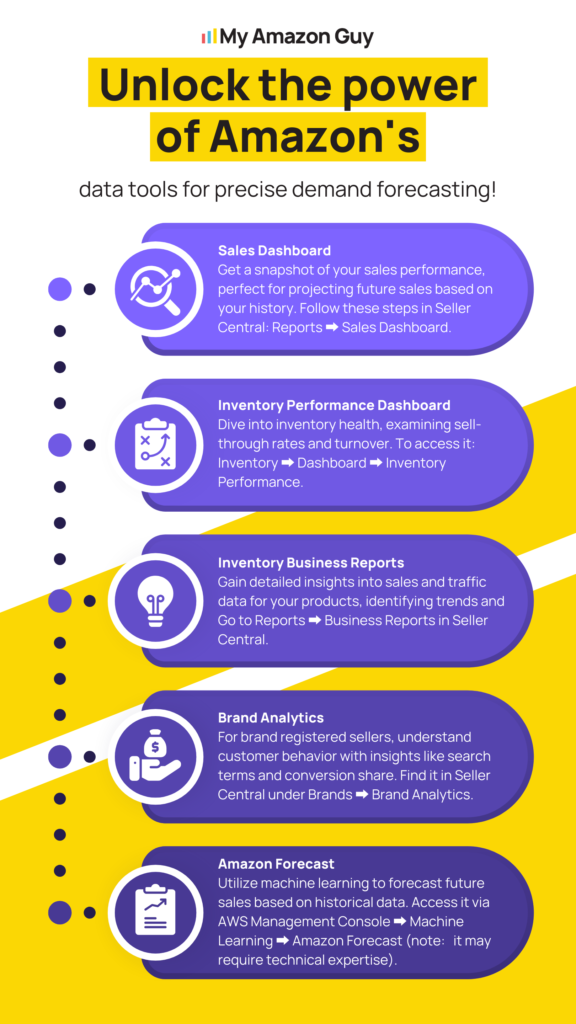Are data silos holding back your Amazon business?
Data silos, where information is isolated in different systems or departments, can be a major problem for Amazon sellers. This guide will look into the dangers of isolated data, explore how they impact both FBA and FBM sellers, and provide actionable strategies to help break down data silos.
By addressing these challenges and implementing effective solutions, you can streamline your operations, make data-driven decisions, and boost your Amazon sales.
Data Silos: What It Is and Why It's a Problem
Data silos occur when information is stored in separate systems or departments, which limits its accessibility and analysis. For Amazon sellers, this means important data is dispersed across various data platforms, making it hard to get a comprehensive view of the business.
Data silos can lead to:
- Poor Decision-Making: Incomplete information makes it difficult to make informed decisions.
- Missed Opportunities: Insights hidden in isolated data can be overlooked.
- Inefficiency: Time and resources are wasted on manual data entry and reconciliation.
- Lower Profits: Fragmented data can negatively affect your bottom line.
Recognizing these issues is the first step toward finding effective solutions.
Dealing with Data Silos as an Amazon FBA Seller
Fulfillment by Amazon (FBA) manages product storage, packaging, and shipping through Amazon’s systems. While this model streamlines many processes, it often leads to siloed data, where inventory, sales, and shipping data are stored separately.
These isolated data sources harm FBA sellers by limiting decision-making and affecting seller performance. Addressing big data silos is essential for FBA sellers to integrate insights, optimize operations, and improve profitability.
Common Data Silos for FBA Sellers
FBA sellers often encounter data silos in the following areas:
Amazon Seller Central vs. External Tools
Data from Seller Central may not match information from accounting, inventory, or marketing tools, making it hard to get a complete financial overview or optimize product listings.
Advertising Platforms
Data from Amazon Advertising and external platforms like Facebook or Google Ads might be disconnected, complicating efforts to measure ROI and allocate your advertising budget effectively.
Customer Data
Customer information from reviews, emails, and social media may be spread across various platforms, making it difficult to understand customer behavior and preferences.
Shipping and Fulfillment Data
While Amazon manages fulfillment, data on shipping performance, costs, and delivery experiences might be limited or inaccessible, affecting your ability to optimize shipping strategies and enhance customer satisfaction.
Integration Challenges for FBA Sellers Due to Data Silos
For FBA sellers, having data silos can result in integration issues, leading to increased operational costs and reduced efficiency. Here are some of the integration-related problems:
- Data Inconsistency: Separate platforms use different data formats, definitions, and terms for the same data elements. For example, a product’s SKU might be defined uniquely in Amazon Seller Central compared to other accounting software or specialty inventory management tools that FBA sellers use. This inconsistency makes it challenging to integrate data accurately.
- Data Duplication: To bridge gaps between systems, sellers often need to manually input data from Amazon Seller Central to other accounting or inventory management systems. This not only consumes time and resources but also increases the risk of errors.
- System Compatibility: Integrating data from different software and tools can be technically complex. Compatibility issues, API limitations, and varying data structures can negatively affect the smooth flow of information between the systems.
Operational Impact for FBA Sellers Due to Data Silos
Unstructured data silos impact the daily operations of FBA sellers since it hinders the smooth operation of an FBA business. Let’s look into how this occurs:
- Delayed Decision-Making: When data is scattered across multiple platforms, it becomes challenging to gather a complete and accurate picture of the business. This delay in obtaining critical information affects the ability to make timely decisions regarding inventory, pricing, marketing, and customer service.
- Inefficient Inventory Management: Without unified data on inventory levels, sales velocity, and supplier performance, it’s hard to maintain optimal stock levels. This leads to stockouts, resulting in lost sales, or overstocking, tying up valuable capital.
- Suboptimal Pricing Strategies: Accurate pricing decisions require relevant data on costs, sales, and competitor pricing. Data silos prevent a holistic view, making it difficult to set competitive prices and maximize profitability.
- Poor Customer Service: Disconnected customer data across various platforms contributes to inefficient customer support and issue resolutions. Customers may experience delays or inconsistencies in responses, negatively impacting customer satisfaction.
Data Utilization Issues for FBA Sellers Due to Data Silos
Data silos hinder FBA sellers from extracting meaningful insights from their existing data. Let’s explore these challenges:
- Limited Insights: When data is fragmented across different platforms, it’s difficult to identify trends, patterns, and correlations. This limits the ability to learn about valuable insights that can contribute to business growth. Limited insights lead to decisions based on incomplete or inaccurate information, potentially resulting in lost sales and reduced profitability.
- Ineffective Performance Analysis: Without a single unified view of key performance indicators (KPIs), it’s challenging to assess the overall health of the business and measure the impact of different strategies. Due to this, it’s difficult to allocate resources effectively, such as marketing budget or inventory levels.
- Increased Costs: Manual data manipulation, cleaning, and analysis consume valuable time and resources, reducing efficiency and profitability. On the other hand, competitors who effectively utilize their data can gain a significant advantage in terms of pricing.
- Missed Opportunity: Isolated data prevents FBA sellers from identifying growth opportunities, and missed opportunities for expansion, product diversification, and market penetration can hinder business growth.
How to Break Down Data Silos as an Amazon FBA Seller
Despite the challenges posed by data silos, there are effective strategies to overcome these obstacles and unlock the full potential of your Amazon business.
Consider AWS
Implement AWS services such as Amazon S3 for data storage, Amazon Redshift for data warehousing, and Amazon QuickSight for data visualization. By utilizing these AWS services, FBA sellers can break down data silos, improve data accessibility, and gain a holistic view of their business operations.
Utilize Amazon's Ecosystem
Leverage tools like Amazon Seller Central, Amazon Advertising, and Amazon Business Reports to their fullest extent. Integrate these platforms with external tools for a more comprehensive view.
Focus on Sales, Marketing, and Customer Data
Prioritize integrating data related to sales, marketing campaigns, and customer interactions for maximum impact. This will help you understand customer behavior, measure marketing ROI, and optimize product listings.
Use Amazon's Analytics
Take advantage of Amazon’s built-in analytics tools to gain insights into sales trends, customer demographics, and product performance. Combine these insights with data from external sources for a more comprehensive analysis.

Example Scenario
Problem:
An FBA seller is struggling to increase sales and improve product visibility. They have data scattered across Amazon Seller Central, Google Analytics, and their email marketing platform.
Solution:
- The seller can start by analyzing Amazon Seller Central to identify top-performing products, customer demographics, and sales trends.
- By integrating Google Analytics with Amazon Seller Central, the seller can track website traffic, conversion rates, and customer behavior. Additionally, they can segment their email list based on purchase history and demographics to send targeted campaigns.
- The seller should utilize Amazon’s built-in analytics tools to identify search terms customers use to find their products. This information is then used to optimize product listings and advertising campaigns.
- For further analysis of large amounts of customer data and purchase history, the seller can use Amazon S3 as data storage.
By implementing these strategies, the seller can:
- Identify high-performing products and target similar items.
- Optimize product listings based on customer search behavior.
- Improve email campaign effectiveness through targeted segmentation.
- Gain a deeper understanding of customer preferences and buying habits.
Dealing with Data Silos as an Amazon FBM Seller
Unlike FBA sellers who rely heavily on Amazon’s infrastructure, Fulfillment by Merchant (FBM) sellers manage their own inventory, shipping, and customer service.
While this offers greater control, it also introduces unique data management challenges due to increased operational complexities. Effectively preventing these data silos can lead to better data accessibility, improved operational efficiency, better decision-making, and ultimately, increased profitability.
Common Data Silos for FBM Sellers
FBM sellers often encounter data scattered across various systems and departments. Common data silos include:
Inventory Management
Data on product quantities, SKUs, and locations can be dispersed across multiple spreadsheets, point-of-sale systems, and warehouse management software if used.
Shipping and Logistics
Information from different shipping carriers, tracking numbers, and delivery statuses might reside in separate systems or platforms.
Customer Data
Customer interactions through email, phone, social media, and online reviews can be scattered across various channels and platforms.
Financial Data
Accounting software, payment gateways, and sales data might not integrate seamlessly, leading to discrepancies in financial reporting.
Operational Impact for FBM Sellers Due to Data Silos
Data silos can significantly impact the day-to-day operations of FBM sellers. Common operational challenges include:
- Inventory Management Challenges: Inaccurate inventory levels across multiple warehouses or locations can lead to stockouts, overstocks, and increased carrying costs.
- Order Fulfillment Delays: Disconnected data between sales, inventory, and shipping can result in order processing errors, delayed shipments, and increased shipping costs.
- Inefficient Shipping Operations: Lack of integrated shipping data can lead to suboptimal carrier selection, longer delivery times, and increased shipping expenses.
- Impaired Customer Service: Disconnected customer data can result in longer resolution times, increased customer frustration, and damage to brand reputation.
Financial Challenges for FBM Sellers Due to Data Silos
Data silos can significantly impact the financial performance of FBM sellers. Common financial challenges include:
- Inaccurate Financial Reporting: Disconnected financial data from sales, inventory, and shipping operations can lead to errors in calculating revenue, cost of goods sold (COGS), and overall profitability.
- Difficulty in cost analysis: Without a clear view of expenses across different departments (e.g., warehousing, shipping, customer service), it’s challenging to identify cost-saving opportunities and allocate resources efficiently.
- Reduced Profitability: Inefficient inventory management due to data silos can result in increased carrying costs, lost sales, and lower profit margins. Additionally, higher shipping costs due to suboptimal carrier selection and routing can negatively impact profitability.
- Impaired Tax Compliance: Inaccurate financial data can lead to errors in calculating sales tax, income tax, and other tax obligations, increasing the risk of audits and penalties.
Strategic Challenges for FBM Sellers Due to Data Silos
Data silos can significantly hinder an FBM seller’s ability to develop and execute effective business strategies. Common strategic challenges include:
- Limited Market Insights: Without a unified view of customer data across different sales channels, it’s difficult to identify target market segments, customer preferences, and purchase behaviors, leading to less effective marketing campaigns.
- Ineffective Marketing Campaigns: Disconnected data on customer interactions, sales performance, and marketing campaign results can hinder the ability to measure ROI, optimize marketing spend, and identify high-performing channels.
- Suboptimal Inventory Management: Lack of integrated data on sales trends, customer demand, and supplier performance can lead to stockouts, overstocks, and missed sales opportunities, impacting overall business profitability.
- Missed Growth Opportunities: Without a comprehensive view of business performance and customer behavior, FBM sellers may overlook potential expansion opportunities, new product lines, or entering new markets.
How to Break Down Data Silos as an Amazon FBM Seller
Overcoming data silos is crucial for FBM sellers to optimize operations and improve profitability. Key strategies include:
Optimized Warehouse Operations
Utilize a warehouse management system (WMS) to streamline picking, packing, and shipping processes, improve order accuracy, and increase efficiency.
Automated Data Integration
Employ integration platforms or custom solutions to connect disparate systems and synchronize data while maintaining data integrity and security.
Robust Inventory Management
Implement a centralized inventory management system to track stock levels, product locations, and reorder points across multiple warehouses, ensuring accurate inventory data and preventing stockouts or overstocks.
Centralized Data Repository
Establish a secure central data repository to consolidate data from various sources, providing a single source of truth for decision-making and enhancing data security.
Data-Driven Decision Making
Leverage business intelligence tools to analyze data, identify trends, and uncover actionable insights to optimize operations and increase profitability.
Streamlined Shipping and Logistics
Integrate shipping software with inventory management and order processing systems to automate shipping label creation, track shipments in real-time, and optimize carrier selection for cost-effective deliveries.
By implementing these strategies and prioritizing data security, FBM sellers can prevent data silos, improve operational efficiency, and enhance overall business performance.
Did you know that Veeqo can be a valuable tool in helping FBM sellers break down data silos? Watch my video and learn how:
Key Points:
- Veeqo Overview: Veeqo is a free inventory and order management platform designed for e-commerce sellers.
- Inventory Management: Veeqo offers robust inventory management features, including tracking stock levels across multiple locations and sales channels.
- Purchase Order Management: The platform allows sellers to manage purchase orders from various suppliers.
- Shipping Management: Veeqo integrates with multiple shipping carriers and offers competitive shipping rates.
- Order Fulfillment: The platform streamlines order processing and fulfillment across different sales channels.
Example Scenario
Problem:
An FBM seller with multiple warehouses is struggling with inventory management, shipping delays, and inaccurate financial reporting. Data is scattered across spreadsheets, point-of-sale systems, and shipping carrier portals.
Solution:
- The seller should invest in a cloud-based inventory management system to centralize data from all warehouses, track stock levels, and manage product information.
- The seller can integrate shipping software (SellBrite or ShipStation) with the inventory management system to automate shipping label creation, track shipments, and calculate shipping costs accurately.
- A data warehouse should be implemented to consolidate data from the inventory management system, shipping software, point-of-sale systems, and accounting software.
- Business intelligence tools must be used to analyze sales trends, inventory performance, and customer behavior to optimize operations and identify growth opportunities.
By implementing these solutions, the FBM seller can:
- Improve inventory accuracy and reduce stockouts or overstocks.
- Streamline order fulfillment processes and reduce shipping costs.
- Enhance customer satisfaction through faster delivery times and accurate order tracking.
- Make data-driven decisions to optimize pricing, marketing, and inventory management.
Breaking Down Data Silos for Amazon Sellers
Traditional data silos have been a hindrance to the growth and profitability of Amazon FBA and FBM sellers. By effectively identifying and addressing the challenges imposed by this issue, sellers can see the full potential of their data.
To overcome these obstacles, Amazon sellers should prioritize data sharing, invest in data warehouse solutions, and establish robust data governance frameworks. Sellers can create a unified view of their business by facilitating seamless data exchange between different systems and departments, enabling data-driven decision-making and improved operational efficiency.
Need professional help to break down data silos? Contact our Amazon agency today!






